Effective Strategies to Deter Possums from Your Garage

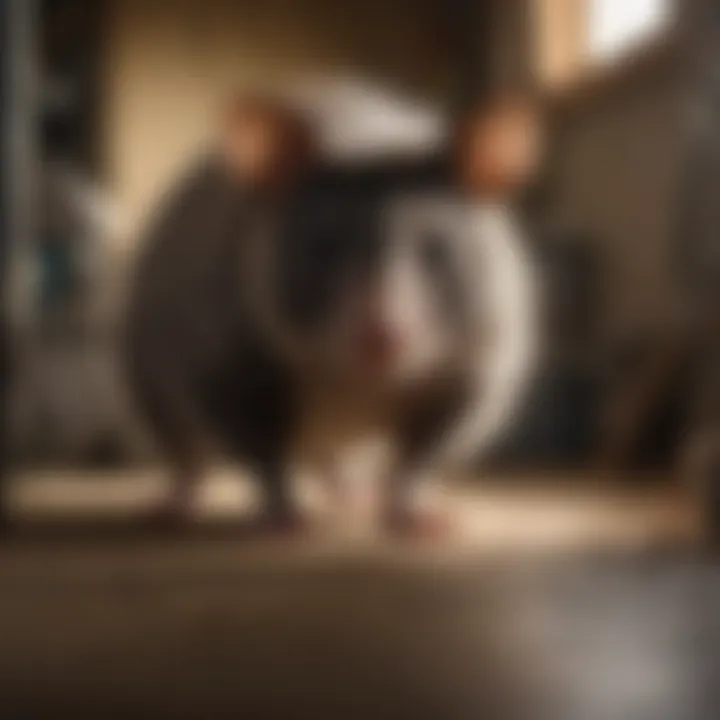
Preventive Pest Control Strategies
Preventing possums from invading your garage requires an understanding of various strategies to mitigate potential risks. This section focuses on practical methods that homeowners can implement to create a less inviting environment for possums.
House Exterior Protection
The outside of your home is the first line of defense against possums. A few alterations can make a significant difference.
Tips for Sealing Cracks
Begin by inspecting the exterior of your house. Look for any cracks or openings in walls, windows, and doors. Seal these gaps using caulk or expanding foam. Not only does this protect against possums, but it also prevents other pests from entering your home. Remember that a small gap can be an invitation for curious animals.
Clearing Debris
Maintaining cleanliness around your home is also crucial. Possums are attracted to scraps of food and clutter. Regularly clear away debris such as leaves, branches, and old furniture from your yard. This not only discourages possums but also enhances the overall appearance of your property.
Preventing Pests from Entering
To ensure that your home remains pest-free, focus on the entry points. Install tight-fitting screens on windows and vents. This reduces the likelihood of small animals finding their way inside. Additionally, consider using door sweeps to prevent access under doors.
Yard Maintenance
Maintaining your yard is essential for any homeowner. An unkempt yard can attract various pests, including possums.
Essential Yard Care Routines
Regular mowing and trimming of hedges can help decrease shrubbery where possums may hide. Keeping your lawn tidy sends a message that your home is not an ideal location for them.
Methods for Keeping Yard Pest-Free
Planting possum-repellent plants like rosemary or lavender can also be beneficial. Additionally, limit the use of mulch; it can attract insects which, in turn, draw in possums seeking food.
Indoor Cleanliness
Keeping your indoor environment clean is just as important as outdoor maintenance. Pests have a higher chance of entering when proper hygiene standards are not met.
Expert Cleaning Tips and Techniques
Develop a regular cleaning schedule. Focus on kitchens and dining areas where food remnants may linger. Ensure that floors are swept and counters are wiped down after meals. Even small crumbs can attract unwanted pests.
Maintaining a Pest-Resistant Indoor Environment
Store food in airtight containers to prevent odors from escaping. This practice discourages possums and other pests from being attracted to your home.
Garbage Disposal
Proper disposal of waste is vital for pest prevention.
Efficient Waste Disposal Methods
Make sure to use bins with secure lids. Closed containers prevent possums from rummaging through your garbage.
Importance of Proper Garbage Disposal
Dispose of garbage regularly. A full trash can is often an open invitation. The goal is to make food sources limited or inaccessible.
Other Pest Prevention Strategies
In addition to the above methods, consider integrating innovative ways to enhance your home’s pest resistance.
Innovative Ways to Safeguard Your Home
Utilize motion-activated lights around your garage and yard. This not only deters possums but also other nocturnal creatures. Furthermore, adding a fence can be an effective physical barrier against entry.
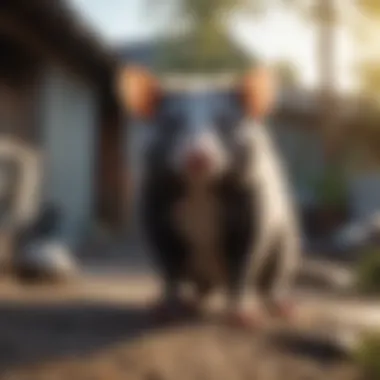

"Proactive measures are more effective and humane than reactive ones when dealing with invasive wildlife."
Taking these steps will help ensure that possums do not view your garage as a suitable habitat.
Understanding Possum Behavior
Understanding possum behavior is crucial for effectively deterring these creatures from intruding into garages. By grasping their habits, preferences, and motivations, homeowners can craft targeted prevention strategies. It is essential to note that possums are not inherently aggressive. Instead, they often seek shelter and food, making it vital to identify what attracts them to your space.
Possums are nocturnal animals, known for being solitary and opportunistic feeders. This means they are active when homeowners are typically indoors, which may lead to surprising encounters if one does gain access to the garage. Knowing their behavioral patterns helps in designing more effective barriers and deterrents.
Moreover, comprehending possum tendencies aids in selecting appropriate deterrent methods. For instance, if an area is particularly attractive to them due to accessible food or shelter, simply sealing entry points might not suffice. You also need to consider aspects such as environmental modifications and changes in maintenance practices.
General Characteristics of Possums
Possums possess several traits that play a significant role in how they behave and interact with their environment. Generally, they are small to medium-sized marsupials, with fur that can range from gray to black, adapted for various climates. Possums have prehensile tails, which assist in climbing and maintaining stability in trees.
Socially, possums are generally solitary creatures. They do not form large groups like some other animals. This alone impacts their foraging habits. They are scavengers, primarily feeding on fruits, vegetables, insects, and small animals. Their opportunistic nature influences their attraction to garages where food might be improperly stored or easily accessible.
Habitat Preferences
In terms of habitat, possums are adaptable and can thrive in both rural and urban areas. They often prefer environments that provide cover, such as dense vegetation or cluttered spaces. Garages, especially those with open gaps or clutter, can become an attractive habitat for these marsupials.
Possums favor areas close to food sources. They typically reside in places with limited disturbances, as they are cautious animals. This means your garage, if unkempt or filled with food sources, can easily attract these creatures. The presence of nearby trees or shrubs can also provide access points and safe pathways for possums.
What Attracts Possums to Garages
Several factors may lure possums into garages. First, the smell of food is a primary attractant. Unsealed bins or left-over pet food can entice possums seeking a meal. Additionally, garages that serve as storage areas may contain various items that can serve as both shelter and foraging locations.
Clutter creates hiding spots, giving possums the sense of security they need to enter. If your garage is disorganized with boxes, tools, or other debris, it might seem like a perfect retreat for them. Possums are also drawn to personal belongings like clothing or blankets, which may offer warmth and protection.
To minimize these risks, attention should be given to regular cleaning and proper food storage practices. Ensuring that your garage is secure and organized will decrease the likelihood of an active possum presence.
Inspection and Identification
Identifying the presence of possums in your garage is a crucial step in effectively managing and deterring these creatures. The process starts with inspection, which provides insight into their behavior, habits, and the most effective strategies for prevention. Early detection can save the trouble of more serious infestations, potentially leading to damage and health risks in your home.
Signs of Possum Presence
Recognizing the signs of possums is key to understanding if you have a problem. Some common indicators include:
- Droppings: Possum droppings are usually dark, shiny, and about the size of a grape. Finding clusters of them is often a clear sign.
- Tracks and Trails: Possums have distinct footprints. Their tracks resemble those of cats, with five toes on the front paws and four on the hind paws.
- Scratches on Surfaces: Look for claw marks on doors, windows, or walls. These may indicate where possums have tried to enter.
- Sounds: Noises in the attic or garage at night may hint at possum activity, especially if you hear scraping or thudding sounds.
To summarize, recognizing these signs plays an important role in guiding your next steps in deterrence and makes it easier to establish preventative measures.
Assessing Potential Entry Points
Once you identify signs of a possum presence, assessing potential entry points becomes essential. Possums are agile and can squeeze through small gaps. Examine your garage carefully. Key areas to focus on include:
- Doors: Check if there are gaps between the door and the frame. Weather stripping can be a great solution here.
- Windows: Older windows often have loose seals and could be an entry point.
- Vents: Ensure that vents are covered with mesh or screens, as they can serve as easy access points.
- Roofline: Inspect overhanging branches that could serve as a bridge to your roof. Trimming branches back can reduce access.
Maintaining awareness of where possums might enter is essential to taking effective action. Inspection and identification are not just about spotting problems; they provide a comprehensive view of how to deter possums and protect your home effectively. By integrating these observations into your strategy, you can enhance both your home's security and its safety.
Preventing Possum Intrusions
Preventing possum intrusions is crucial for homeowners aiming to maintain a safe and clean garage environment. Possums are nocturnal creatures that often invade spaces where there are easy food sources or shelter. By taking preventive measures, you can significantly reduce the likelihood of these animals making your garage their home. Such actions not only protect your property but also promote humane treatment of wildlife. The key aspects to consider include sealing entry points and removing attractants.
Sealing Entry Points
Assessing Window and Door Seals
Assessing window and door seals is an essential step in preventing possum intrusions. Possums can squeeze through surprisingly small openings, so a thorough inspection of these areas is necessary. Check for gaps or wear where the seals may have deteriorated. Ensuring that all seals are intact prevents possums from entering your garage and establishing a nest. This method is effective since possums are unlikely to expend effort trying to enter a well-sealed space. The benefits of assessing these seals include reduced risks of other pest issues and lower exposure to potential health hazards.
Using Appropriate Materials
Using appropriate materials for sealing is critical for long-term success in keeping possums out. Materials such as heavy-duty weather stripping, silicone caulk, or expanding foam can provide an effective barrier against intrusions. These materials can withstand a range of weather conditions, which is essential for maintaining their integrity over time. The unique feature of using these materials is their durability, as they can last for years with minimal maintenance. While there can be an initial cost in purchasing high-quality sealing materials, the long-term benefits in prevention far outweigh this expense.

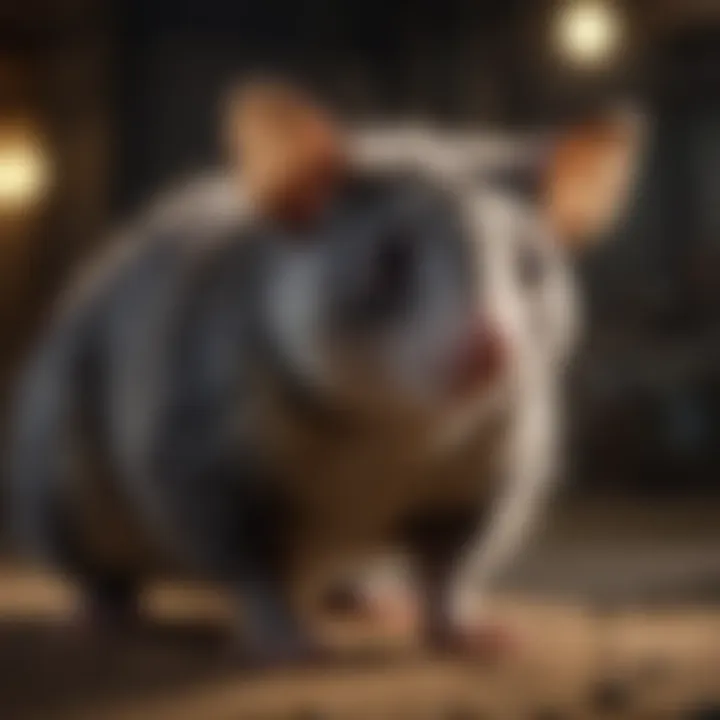
Removing Attractants
Storing Food Properly
Storing food properly contributes significantly to deterring possums. Since possums are opportunistic feeders, accessible food sources can lure them into your garage. Make sure that any food items, including pet food, are sealed in airtight containers. This prevents odors from attracting possums and other wildlife. The key characteristic of proper food storage is its simplicity and effectiveness, making it a popular choice for many homeowners. Besides deterring possums, this practice can also protect numerous foods from spoilage and pests.
Clearing Debris and Clutter
Clearing debris and clutter is another practical approach to keep possums at bay. Possums often seek shelter in cluttered or messy areas. Regularly cleaning the garage and removing items that are not in use can minimize hiding places for these animals. The unique feature of a clean and organized garage is that it becomes less appealing to possums, who prefer environments that provide cover and shade. While cleaning may take time and effort, it also enhances the usability of your space, providing added benefits beyond possum prevention.
"The best defense against unwanted wildlife is a proactive approach that focuses on prevention and maintenance."
By implementing these strategies to seal entry points and remove attractants, homeowners can create a more hostile environment for possums, making their garage less inviting. These techniques not only enhance the protection of your property but also foster a greater understanding of coexistence with local wildlife.
Using Deterrents
Using deterrents plays a vital role in keeping possums away from your garage. These methods focus on altering the environment to make it less appealing to these nocturnal creatures. By integrating sound-based, scent-based, and visual deterrents, homeowners can significantly reduce the likelihood of possum intrusion.
Consideration of these deterrents not only helps in the immediate situation but also promotes a more long-term strategy for prevention. The objective is to create an environment that discourages possums from approaching, minimizing any potential conflict and safeguarding both home and wildlife.
Sound-Based Deterrents
Sound-based deterrents can be effective in keeping possums at bay. These devices work by emitting sounds that are uncomfortable for possums but inaudible to humans, making them a subtle yet effective option.
Ultrasonic Devices
Ultrasonic devices are popular for repelling possums. They emit high-frequency sounds that irritate pests without impacting human occupants. The key characteristic of these devices is their inaudibility to the human ear, allowing for discreet protection.
Their unique feature lies in the adjustable frequencies, which can be tuned to target specific wildlife. The advantage is their ease of installation and low maintenance. However, some individuals may question their effectiveness over time, as animals can become desensitized.
Natural Sound Sources
Natural sound sources, such as the sounds of predators, also serve as effective deterrents. These can include recordings of owls or other animals that might threaten possums. The principle behind this method is straightforward; mimicking the presence of natural predators makes a place uninviting.
This method is beneficial as it relies on natural behaviors of possums and does not require special equipment. However, obtaining suitable sound recordings and ensuring they are played intermittently can present some challenges.
Scent-Based Deterrents
Scent-based deterrents work by appealing to the possum’s keen sense of smell. These methods can mask areas with odors that possums find unpleasant.
Predator Urine
Predator urine, notably from foxes or coyotes, can be particularly effective. Its strong scent signals danger to possums, discouraging them from entering areas where it is detected. This key characteristic makes it a powerful deterrent, leveraging the natural instincts of the possum.
The unique feature of predator urine is its long-lasting effect, with some brands offering extended release options. While it is popular among homeowners, there can be concerns about its ethical implications and the potential for affecting other wildlife in the area.
Citrus and Vinegar Solutions
Citrus and vinegar solutions are other options homeowners can utilize. The sharp scents from these substances are typically disliked by possums, making them an ideal addition to a deterrent strategy. This method is beneficial as it is inexpensive and safe for both pets and children.
However, the unique feature of these solutions is that they require consistent application. Over time, the scents may fade, necessitating more frequent reapplication to maintain effectiveness.
Visual Deterrents
Visual deterrents are tactics that impact how possums perceive an area. They can create a sense of unease that discourages these animals from approaching your garage.
Reflective Surfaces
Reflective surfaces, such as aluminum foil or reflective tape, can confuse and unsettle possums. The key characteristic is their ability to reflect light, creating a visual disturbance that makes a location feel unsafe.
This method is easy to implement and is also cost-effective. However, the challenge lies in ensuring that the reflective materials remain secured and do not degrade in outdoor conditions.
Motion-Activated Lighting
Motion-activated lighting is another effective visual deterrent. These lights illuminate when they detect movement, startling possums and encouraging them to leave. The advantage of this method is its dual function; it enhances overall garage security while deterring unwanted wildlife.
However, one consideration is that the lights may unintentionally disrupt other nocturnal visitors, thus requiring careful monitoring to assess overall effectiveness.
Ultimately, using a combination of these deterrents can provide a more comprehensive approach to preventing possums from making your garage their home.
Humane Removal Techniques
Humane removal techniques are critical in managing possum intrusions while ensuring animal welfare. These techniques emphasize the importance of humanely capturing and relocating possums instead of harming them. Homeowners should recognize that possums play a role in the ecosystem and that their displacement should be carried out with care. This section discusses how to approach possum removal responsibly, fostering a balance between protecting property and respecting wildlife.
Trapping Possums Safely
Choosing the Right Trap
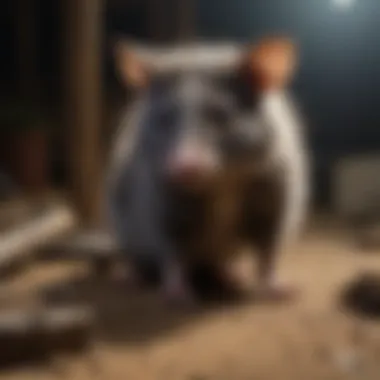
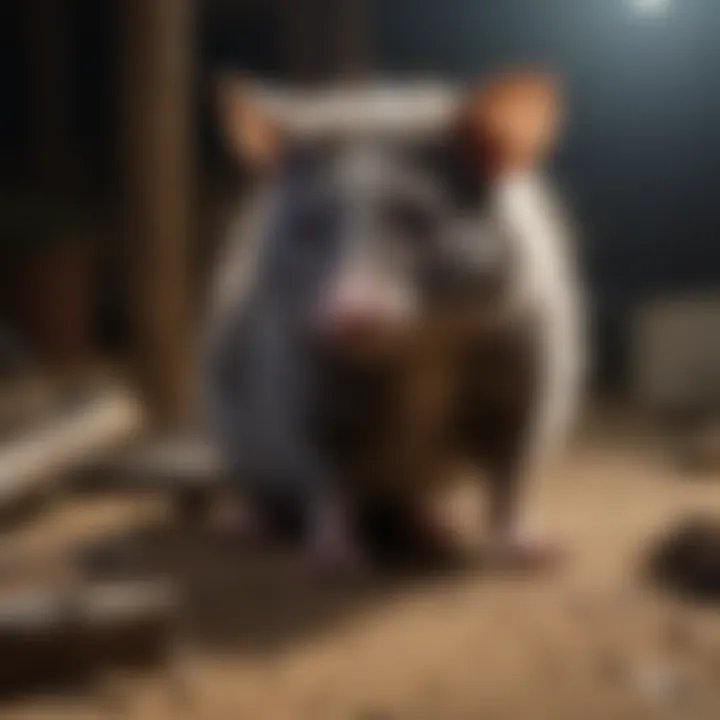
Choosing the right trap is essential for successful and humane possum removal. The most effective traps are generally live traps, designed to capture animals without causing harm. These traps typically utilize a bait system that attracts the possum inside. A key characteristic of live traps is their size, which should be adequate to comfortably enclose a possum. Notably, traps like the Havahart Live Animal Trap are widely used because they are easy to operate and are constructed from sturdy materials. This type of trap ensures that the possum is safe during capturing, thus preventing injury or stress.
Benefits: Live traps allow for easy monitoring, making it convenient to check and relocate the animal promptly. Using proper traps also reflects a responsible attitude towards local wildlife, contributing positively to the homeowner's ethics.
Disadvantages: However, it is important to note that not all traps are created equally. Some low-quality traps might fail to capture the animal effectively, potentially leading to prolonged exposure for the possum.
Setting the Trap Correctly
Setting the trap correctly is as crucial as choosing the right one. Proper setting ensures that the trap functions effectively in luring the possum while maintaining their safety. Key to this process is positioning the trap in a location with evident recent activity, such as near droppings or visible trails. Additionally, bait should be used wisely; fruits like apples or bananas have proven to be effective in attracting possums.
The unique feature of properly setting a trap is ensuring that it is stable and hidden from sight, which helps in reducing the stress of the animal once captured. This consideration improves the chances of a successful capture.
Advantages: Correctly positioned traps minimize accidental captures of non-target species, making it a beneficial choice for both homeowners and wildlife alike. This attention to detail in trap setting is vital for humane removal efforts.
Disadvantages: An improperly set trap can lead to missed opportunities, prolonging the issue of possum infestation in the garage.
Relocation Considerations
Finding Suitable Relocation Areas
Finding suitable relocation areas is a fundamental aspect of humane removal. When a possum is captured, homeowners must consider where to release it. Choosing an area away from urban settings is ideal, as possums thrive in environments that offer shelter and access to food. A naturalized area like a park or forest is preferable for their wellbeing.
The key characteristic of locating suitable areas for release lies in the ecosystem's health. A healthy ecosystem provides possums with resources necessary for survival after relocation. Releasing possums in an unfavorable area can lead to stress and increase the risk of predation.
Benefits: This attention to relocation areas ensures that possums can adapt and integrate back into their natural habitat, reducing their chances of returning to residential areas.
Disadvantages: The challenge can arise when suitable areas are scarce, particularly in developed regions with limited green spaces, making it crucial to plan carefully.
Adhering to Local Wildlife Laws
Adhering to local wildlife laws is paramount while considering possum removal and relocation. These laws are established to protect both wildlife and the environment, ensuring that residents conduct their actions responsibly. Understanding regulations about trapping, removing, and relocating wildlife helps avoid potential legal consequences.
The unique feature of following these laws is that they often require notifying local wildlife agencies, especially for certain species or populations that might be protected. Knowledge of these regulations not only promotes ethical practices but also creates a safer environment for both humans and animals.
Advantages: Compliance with local wildlife laws assures homeowners that their actions are not only ethical but also justified legally. This approach fosters positive relationships with local wildlife authorities, which can be beneficial for future encounters with possums or other wildlife.
Disadvantages: Non-compliance can lead to penalties, fines, or even required restitution, impacting the homeowner’s experience in dealing with wildlife.
In summary, humane removal techniques prioritize animal welfare while addressing the practical challenges of possum management. By focusing on the right traps, proper settings, suitable relocation areas, and law adherence, homeowners can navigate possum problems effectively.
Post-Removal Strategies
After successfully removing possums from your garage, the focus shifts to implementing effective post-removal strategies. These strategies are crucial not only for ensuring that the unwanted guests do not return but also for maintaining a clean and secure environment within your home. Addressing the aftermath of a possum intrusion involves continuous monitoring, environmental adjustments, and community engagement.
Monitoring for Re-Entry
Monitoring for re-entry is a vital strategy in maintaining a possum-free garage. This process involves regularly inspecting the garage for signs of possum activity. Homeowners should check for droppings, scratches on walls, or disturbed areas that might indicate a possum's presence. By staying vigilant, you can catch a potential re-entry early. The goal is to identify any weaknesses in your previous preventative measures, assuring that they are still effective.
Additionally, using trail cameras can be beneficial. These cameras can capture nocturnal movements and help gauge whether your preventive strategies are working or if adjustments are needed. Establishing a monitoring routine not only helps in keeping possums at bay but also instills peace of mind, knowing that you can quickly respond to any sign of trouble.
Long-Term Prevention Practices
Regular Garage Maintenance
A significant aspect of long-term prevention is ensuring regular garage maintenance. This involves a systematic approach to keeping the space tidy and secure. Regularly cleaning your garage reduces clutter, which can serve as potential hiding spots for possums. Moreover, checking for and repairing any holes or openings in walls, floors, and the roof can further minimize chances of re-entry.
One of the key characteristics of regular garage maintenance is its proactive nature. This process prevents problems before they arise rather than simply reacting to them after the fact. Routine maintenance can easily become a beneficial habit for homeowners, saving time and costs associated with both cleaning and potential pest control.
However, one unique feature of regular garage maintenance is its comprehensive nature. It encompasses a variety of tasks, from organizing tools to ensuring proper ventilation. Its main advantage lies in creating an unwelcoming environment for possums, thus supporting your overall goal of deterrence.
Community Awareness on Possum Behavior
Incorporating community awareness on possum behavior is another essential post-removal strategy. Engaging with neighbors can enhance the effectiveness of your individual efforts. Sharing insights on possum behavior and preventive methods can foster a united front against these creatures.
Community awareness has become a popular concept, as it emphasizes the importance of collective action in pest control. When multiple households are knowledgeable about possum habits, the likelihood of widespread success increases. Moreover, local groups can help distribute resources, such as information pamphlets or talks on wildlife awareness.
A unique feature of community engagement is that it addresses the broader issue rather than focusing solely on individual homes. This interconnected approach can highlight underlying environmental problems, which might attract possums to multiple areas. Nevertheless, one disadvantage of community initiatives may be the varying levels of engagement among neighbors, which can lead to inconsistent success rates.
"By fostering a sense of community responsibility, homeowners can significantly enhance their management of possum populations."
In summary, implementing effective post-removal strategies involves continuous observation and community collaboration. Regular maintenance and shared knowledge contribute greatly to creating an environment that deters possums and promotes lasting solutions.



